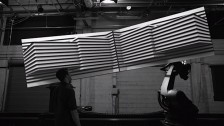For class 2/3/14
Post Comments by 11:59 pm on 2/2/14
The Ultimate Display
by Ivan Sutherland, 1965
comments by Bruce Sterling, 2009
http://www.wired.com/beyond_the_beyond/2009/09/augmented-reality-the-ultimate-display-by-ivan-sutherland-1965/
A Note on Presence Terminology
Mel Slater
http://s3.amazonaws.com/publicationslist.org/data/melslater/ref-201/a%20note%20on%20presence%20terminology.pdf
Please print out these articles and bring them with you to class on Monday for discussion. Alternatively, you can bring digital versions of the reading with you.
Discussion (comment on these questions below):
Post 1: The Ultimate Display
Bruce Sterling lists a number of present day technologies which match the concepts which Sutherland was describing. What do you believe was the most influential of these developed technologies?
What do you think of how Slater ends the article? Why do you think Sutherland choose to use such menacing imagery?
Can you name another current technology which which matches Sutherland’s concepts but is not included in Sterling’s listings (and describe it in a few sentences and how it relates)? If you can’t, write a paragraph about elaborating on how the technology Sterling points to in his article are still used today.
Post 2
Do you agree with the separation of presence and immersion? Does this differentiation make sense to you?
What do you think of Slater’s argument about presence in simulations of the Non-Real? Do you agree that Presence is possible in impossible environments?
Finally, select a topic that you find interesting, dubious, confusing or curious and explain why. Write at least a paragraph of explanation and add citations if warranted.




